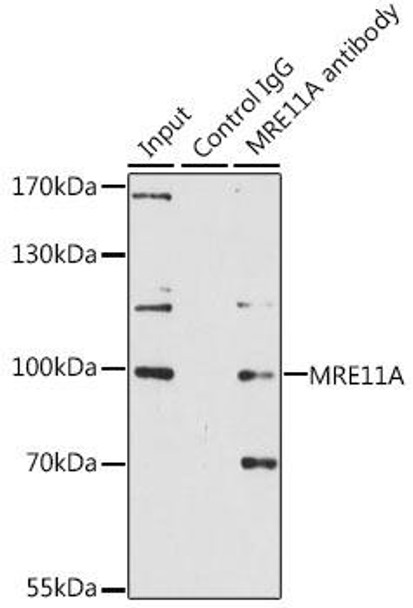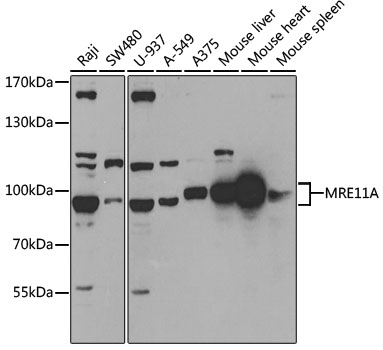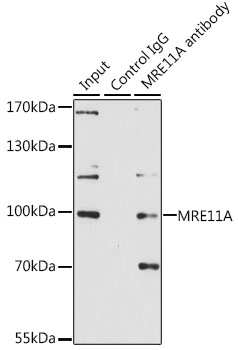Anti-MRE11A Antibody (CAB2559)
- SKU:
- CAB2559
- Product type:
- Antibody
- Reactivity:
- Human
- Reactivity:
- Mouse
- Reactivity:
- Rat
- Host Species:
- Rabbit
- Isotype:
- IgG
- Research Area:
- Epigenetics and Nuclear Signaling
Description
| 抗体名: | Anti-MRE11A Antibody |
| 抗体コード: | CAB2559 |
| 抗体サイズ: | 20uL, 50uL, 100uL |
| 申し込み: | WB IF IP |
| 反応性: | Human, Mouse, Rat |
| 宿主種: | Rabbit |
| 免疫原: | Recombinant fusion protein containing a sequence corresponding to amino acids 1-205 of human MRE11A (NP_005581.2). |
| 申し込み: | WB IF IP |
| 推奨希釈: | WB 1:500 - 1:2000 IF 1:50 - 1:200 IP 1:50 - 1:100 |
| 反応性: | Human, Mouse, Rat |
| ポジティブサンプル: | Raji, SW480, U-937, A-549, A-375, Mouse liver, Mouse heart, Mouse spleen |
| 免疫原: | Recombinant fusion protein containing a sequence corresponding to amino acids 1-205 of human MRE11A (NP_005581.2). |
| 精製方法: | Affinity purification |
| ストレージバッファ: | Store at -20'C. Avoid freeze / thaw cycles. Buffer: PBS with 0.02% sodium azide, 50% glycerol, pH7.3. |
| アイソタイプ: | IgG |
| 順序: | MSTA DALD DENT FKIL VATD IHLG FMEK DAVR GNDT FVTL DEIL RLAQ ENEV DFIL LGGD LFHE NKPS RKTL HTCL ELLR KYCM GDRP VQFE ILSD QSVN FGFS KFPW VNYQ DGNL NISI PVFS IHGN HDDP TGAD ALCA LDIL SCAG FVNH FGRS MSVE KIDI SPVL LQKG STKI ALYG LGSI PDER LYRM FVNK KVTM LRPK E |
| 遺伝子ID: | 4361 |
| Uniprot: | P49959 |
| セルラーロケーション: | Nucleus |
| 計算された分子量: | 77kDa/80kDa/81kDa |
| 観察された分子量: | 90kDa-100kDa |
| 同義語: | MRE11, ATLD, HNGS1, MRE11A, MRE11B |
| バックグラウンド: | This gene encodes a nuclear protein involved in homologous recombination, telomere length maintenance, and DNA double-strand break repair. By itself, the protein has 3' to 5' exonuclease activity and endonuclease activity. The protein forms a complex with the RAD50 homolog; this complex is required for nonhomologous joining of DNA ends and possesses increased single-stranded DNA endonuclease and 3' to 5' exonuclease activities. In conjunction with a DNA ligase, this protein promotes the joining of noncomplementary ends in vitro using short homologies near the ends of the DNA fragments. This gene has a pseudogene on chromosome 3. Alternative splicing of this gene results in two transcript variants encoding different isoforms. |
| UniProt Protein Function: | MRE11A: a nuclear protein involved in homologous recombination, telomere length maintenance, and DNA double-strand break repair. By itself, the protein has 3' to 5' exonuclease activity and endonuclease activity. The protein forms a complex with the RAD50 homolog; this complex is required for nonhomologous joining of DNA ends and possesses increased single-stranded DNA endonuclease and 3' to 5' exonuclease activities. In conjunction with a DNA ligase, this protein promotes the joining of noncomplementary ends in vitro using short homologies near the ends of the DNA fragments. Alternative splicing results in two different isoforms. |
| UniProt Protein Details: | Protein type:DNA-binding; Cell cycle regulation; DNA repair, damage; Deoxyribonuclease Chromosomal Location of Human Ortholog: 11q21 Cellular Component: nucleoplasm; chromosome, telomeric region; Mre11 complex; cytosol; nucleus; chromatin Molecular Function:protein C-terminus binding; ATP-dependent DNA helicase activity; protein binding; nuclease activity; DNA binding; single-stranded DNA specific endodeoxyribonuclease activity; manganese ion binding; endonuclease activity; double-stranded DNA binding; 3'-5' exonuclease activity; endodeoxyribonuclease activity Biological Process: positive regulation of kinase activity; sister chromatid cohesion; negative regulation of DNA endoreduplication; telomere maintenance via telomerase; DNA repair; regulation of mitotic recombination; DNA catabolic process, endonucleolytic; positive regulation of protein amino acid autophosphorylation; DNA duplex unwinding; double-strand break repair via nonhomologous end joining; double-strand break repair via homologous recombination; DNA recombination; cell proliferation; intra-S DNA damage checkpoint; base-excision repair; nucleotide-excision repair; meiotic recombination; double-strand break repair; mitotic cell cycle G2/M transition DNA damage checkpoint; synapsis; positive regulation of interferon type I production; innate immune response; telomere maintenance; response to DNA damage stimulus Disease: Ataxia-telangiectasia-like Disorder 1 |
| NCBI Summary: | This gene encodes a nuclear protein involved in homologous recombination, telomere length maintenance, and DNA double-strand break repair. By itself, the protein has 3' to 5' exonuclease activity and endonuclease activity. The protein forms a complex with the RAD50 homolog; this complex is required for nonhomologous joining of DNA ends and possesses increased single-stranded DNA endonuclease and 3' to 5' exonuclease activities. In conjunction with a DNA ligase, this protein promotes the joining of noncomplementary ends in vitro using short homologies near the ends of the DNA fragments. This gene has a pseudogene on chromosome 3. Alternative splicing of this gene results in two transcript variants encoding different isoforms. [provided by RefSeq, Jul 2008] |
| UniProt Code: | P49959 |
| NCBI GenInfo Identifier: | 17380137 |
| NCBI Gene ID: | 4361 |
| NCBI Accession: | P49959.3 |
| UniProt Secondary Accession: | P49959,O43475, B3KTC7, |
| UniProt Related Accession: | P49959 |
| Molecular Weight: | 708 |
| NCBI Full Name: | Double-strand break repair protein MRE11A |
| NCBI Synonym Full Names: | MRE11 meiotic recombination 11 homolog A (S. cerevisiae) |
| NCBI Official Symbol: | MRE11A |
| NCBI Official Synonym Symbols: | ATLD; HNGS1; MRE11; MRE11B |
| NCBI Protein Information: | double-strand break repair protein MRE11A; AT-like disease; MRE11 homolog 1; MRE11 homolog A; endo/exonuclease Mre11; meiotic recombination 11 homolog 1; meiotic recombination 11 homolog A; DNA recombination and repair protein |
| UniProt Protein Name: | Double-strand break repair protein MRE11A |
| UniProt Synonym Protein Names: | Meiotic recombination 11 homolog 1; MRE11 homolog 1; Meiotic recombination 11 homolog A; MRE11 homolog A |
| Protein Family: | Double-strand break repair protein |
| UniProt Gene Name: | MRE11A |
| UniProt Entry Name: | MRE11_HUMAN |



